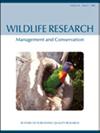Combining acoustic localisation and high-resolution land cover classification to study predator vocalisation behaviour
IF 1.6
3区 生物学
Q3 ECOLOGY
引用次数: 0
Abstract
ABSTRACT Context. The ecology of cryptic animals is difficult to study without invasive tagging approaches or labour-intensive field surveys. Acoustic localisation provides an effective way to locate vocalising animals using acoustic recorders. Combining this with land cover classification gives new insight into wild animal behaviour using non-invasive tools. Aims. This study aims to demonstrate how acoustic localisation – combined with high-resolution land cover classification – permits the study of the ecology of vocalising animals in the wild. We illustrate this technique by investigating the effect of land cover and distances to anthropogenic features on coyote and wolf vocal behaviour. Methods. We collected recordings over 13 days in Wisconsin, USA, and triangulated vocalising animals’ locations using acoustic localisation. We then mapped these locations onto land cover using a high-resolution land cover map we produced for the area. Key results. Neither coyotes nor wolves vocalised more in one habitat type over another. Coyotes vocalised significantly closer to all human features than expected by chance, whereas wolves vocalised significantly further away. When vocalising closer to human features, coyotes selected forests but wolves showed no habitat preference. Conclusions. This novel combination of two sophisticated, autonomous sensing-driven tools permits us to examine animal land use and behavioural ecology using passive sensors, with the aim of drawing ecologically important conclusions. Implications. We envisage that this method can be used at larger scales to aid monitoring of vocally active animals across landscapes. Firstly, it permits us to characterise habitat use while vocalising, which is an essential behaviour for many species. Furthermore, if combined with additional knowledge of how a species’ habitat selection while vocalising relates to its general habitat use, this method could permit the derivation of future conclusions on prevailing landscape use. In summary, this study demonstrates the potential of integrating acoustic localisation with land cover classification in ecological research.结合声学定位和高分辨率土地覆盖分类来研究捕食者的发声行为
本文章由计算机程序翻译,如有差异,请以英文原文为准。
求助全文
约1分钟内获得全文
求助全文
来源期刊

Wildlife Research
生物-动物学
CiteScore
4.30
自引率
15.80%
发文量
56
审稿时长
3 months
期刊介绍:
Wildlife Research represents an international forum for the publication of research and debate on the ecology, management and conservation of wild animals in natural and modified habitats. The journal combines basic research in wildlife ecology with advances in science-based management practice. Subject areas include: applied ecology; conservation biology; ecosystem management; management of over-abundant, pest and invasive species; global change and wildlife management; diseases and their impacts on wildlife populations; human dimensions of management and conservation; assessing management outcomes; and the implications of wildlife research for policy development. Readers can expect a range of papers covering well-structured field studies, manipulative experiments, and analytical and modelling studies. All articles aim to improve the practice of wildlife management and contribute conceptual advances to our knowledge and understanding of wildlife ecology.
Wildlife Research is a vital resource for wildlife scientists, students and managers, applied ecologists, conservation biologists, environmental consultants and NGOs and government policy advisors.
Wildlife Research is published with the endorsement of the Commonwealth Scientific and Industrial Research Organisation (CSIRO) and the Australian Academy of Science.
 求助内容:
求助内容: 应助结果提醒方式:
应助结果提醒方式:


